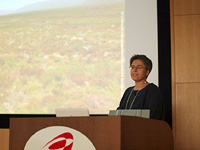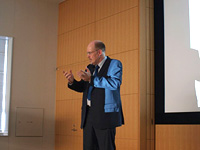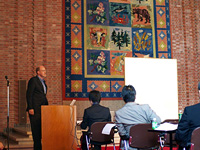An international symposium was held on CREST Research Area: Establishment of Innovative Manufacturing Technology Based on Nanoscience (Research Supervisor: Yasuhiro Horiike, Fellow Emeritus, National Institute for Materials Science), and Research Theme: Development of Hierarchically Structured Biomimetics/Nanosurface Construction Technology (Symposium Chair: Professor Masatsugu Shimomura, Tohoku University).
Since the beginning of this century, new functional materials that mimic living organisms began to be developed, mainly in Europe. New materials which mimic the unique nanomicro structures that insect or plant surfaces have and their diverse functions, such as the self-cleaning surface which mimic the superhydrophobicity of lotus leaves, the anti-reflection coating which mimic the moth-eye, and the adhesion tapes which mimic the structure of gecko lizard fingers, have been attracting peopleís attention. The tide of the next-generation biomimetic materials research in Europe and the U.S. generated a new academic discipline based on an intimate interdisciplinary fusion of biology and materials science united by the development of nanotechnology. In the industry, the new trend of biomimetics is expected to bring a paradigm shift and technical innovation in the energy/resource conservation type of manufacturing. On the other hand, research and development of micromachines and robots based on biomechanics is very active in Japan, but research of materials science is not so active. Accordingly, this symposium was held in Tokyo and Sapporo for the purpose of gathering information on the current status of biomimetic research in the world, discussions on issues that Japanís academic system and industrial structure have that need to be resolved, and at the same time, to provide a venue for mutual exchange and collaboration among biologists, material scientists, and corporate researchers/developers. At Sapporo in particular, we were conscious about the collaboration with natural history, which is likely to play an important role in the future research of biomimetics in Japan, and organized it as a cooperative effort with the Historical Museum of Hokkaido.



At this symposium, we focused on the subjects listed below, and oral presentations were given by active researchers in and out of Japan from a diverse academic field such as insect biology, physiology, physics, hydrodynamics, surface science, polymer science, biochemistry, mechanical engineering, inorganic chemistry and enviromentology. Poster sessions were also held, including presentations by corporations in and out of Japan which are aggressively pursuing the industrialization of biomimetics. (1) "Nanobiology/self-organization/self-assembly" (Biomaterials, self-organization/assembly systems in living organisms and their mimetics, hierarchical properties in living organisms, biomimeticchemistry, molecular machines, etc.) (2) "Biomineralization" (Biomineralization and mimetics, organic/inorganic hybrid materials, etc.) (3) "Biomechanics" (Cellular biomechanics, cellular mechanics, materials mechanics, etc.) (4) "Tribology, fluidics" (Surface treatment, biotribology, biofluidics, etc.) (5) "Superhydrophobic, superhydrophilic, wettability" (Surface treatment, erosion/corrosion, metal surface processing, etc.) (6) "Sensing" (Taste, smell, optical, thermal, chemical sensors, imaging, etc.) (7) "Photonics/optics" (Photosynthesis, artificial photosynthesis, vision, mothís eyes, structural color, liquid crystals, optical switches, etc.) (8) "Bioenergetics, nature technology" (Bioelectrogenesis, photosynthesis, low environmental burden technology, etc.)
This international symposium was the first venue in Japan to have collaboration between biology and engineering/materials science as well as business and academia, with biomimetics as a keyword, and it offered a valuable opportunity to discuss the possibility of biomimetics from an engineering point of view. Through the participation and discussion among researchers and corporations from different fields, we were strongly convinced that material science and engineering can effectively bring out the potential of biology/natural history, and this can contribute to the realization of low environmental burden/energy conservation process and energy conservation materials/systems. This symposium was meaningful in bringing home a point that in order to design new materials from the tide of biomimetics, then developed them to engineering and to also compete with Europe and the U.S. in this field, it is necessary to not only uncover the knowledge and technology of material science and nanotechnology, but also to seriously uncover and utilize the accumulated knowledge of biology/natural history.
JST, an integrated organization of science and technology in Japan, establishes an infrastructure for the entire process from the creation of knowledge to the return to the society. For more information, visit http://www.jst.go.jp/EN/